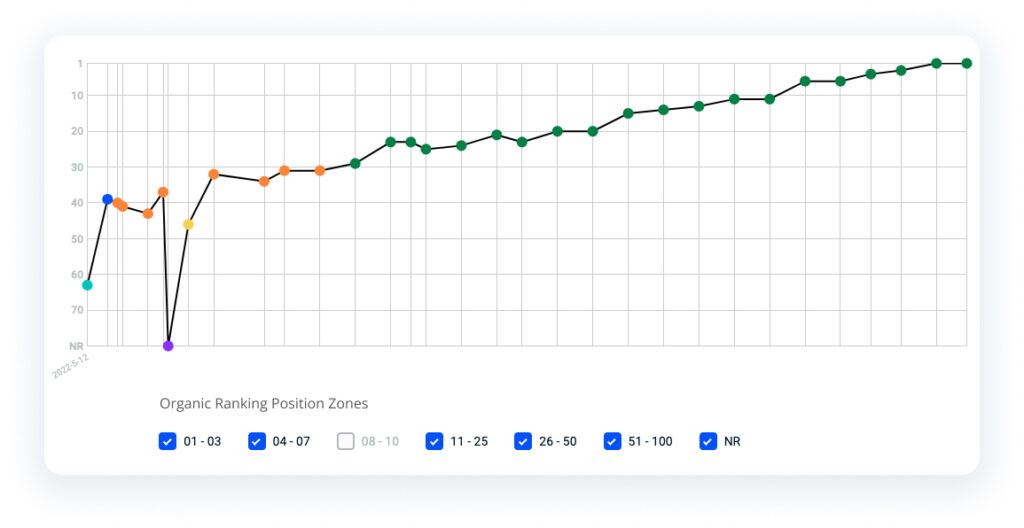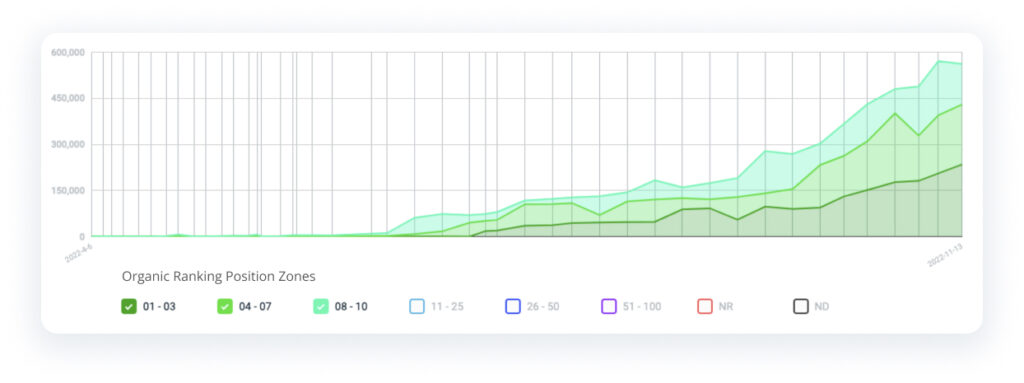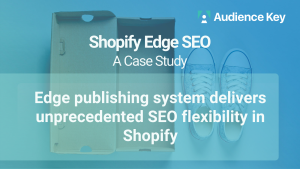Shopify is one of the most-used ecommerce platforms because of its ease of use, visual appeal, and low entry price point. However, a well-known limit of Shopify is the inability to customize website taxonomy, which hinders retailers’ organic search performance.
And the bigger the retailer, the bigger the hindrance. Using an approach called “edge publishing” and an innovative keyword mapping system, a 7-year-old ecommerce site gained a 3,000% year-over-year increase in non-branded clicks.
An agency team used Audience Key, an SEO strategy platform in conjunction with its Audience Edge publishing feature to overcome Shopify’s inherent taxonomy limitations. The one of a kind keyword mapping and content optimization software supported planning and scalable development and publishing of mid to long tail category pages featuring a multi-level taxonomy structure. The result was a huge SEO traffic windfall within six months.
120
SEO Edge category pages created
560k
Monthly page one impressions gained
21k
Monthly new non-branded SEO visitors
Shopify’s Ecommerce Challenges
A Shopify ecommerce site with over 2,000 active SKUs faced limited SEO performance. The site performed poorly for non-branded organic search traffic, impeded by a host of challenges including:
1. Category Taxonomy Restrictions
For sites with large product catalogs, Shopify’s Collections pages force a single level of category taxonomy, which is a significant blocker to SEO success.
Ideal URL structure example: (you can’t do this in Shopify!)
sneakerwebsite.com/category/shoes/womens/running/terrain
Forced structure for Shopify URLs
sneakerwebsite.com/collections/womens-terrain-running-shoes
The single level of depth means missing taxonomy, breadcrumbs, thematic silo grouping… a host of SEO benefits are out of reach.
2. The Page by Page Segmentation Challenge
Sites wishing to significantly expand their mid to long-tail category coverage find it challenging to optimally segment and plan out proper category page delineation. How many different categories should we have? Where is the blurry line between “too granular” vs. “not granular enough”? How can this be measured and readily assessed over time?
3. Alignment of Keyword Strategy & Page Publishing at Scale
Developing and aligning SEO metadata and supportive static category content at scale is challenging to properly plan, implement, and measure.
Our 4-step solution leveraging sub-sub-sub… Collections CATEGORY pages
1. Identify and organize opportunities into a cohesive execution plan.
Utilizing the one-of-a-kind keyword mapping software in Audience Key, we identified over 20,000 keywords and evaluated them for a large Shopify retail site. We mapped 1,900 of these terms (all non-branded) to a new section of strategic long-tail category page groupings (pages living outside of the /collections/ area of Shopify).
- The plan holistically accounted for the proper organization and delineation of hundreds of planned long tail category pages.
- The system output informed page-level detail for the best determinations toward SEO metadata, supporting category content, and internal linking.
2. Intelligently build page-level content for each new category page (not collections pages).
- Leveraging the content briefs created for each new planned category page, we created customized content for each page, including title tags, meta descriptions, descriptive header and body content, and internal links to related categories.
- By producing SEO content and metadata inside the very system that manages the keyword targeting strategy, the commonplace disconnect between content strategy and content production was ameliorated.
3. Publish all category page content to the “edge” via Cloudflare CDN.
Using Audience Edge, the publishing technology component inside Audience Key, allowed for the system to act as a serverless conduit. We published all category page content elements from the content briefs out to the edge via Cloudflare CDN.
- Complete URL structure flexibility was afforded to create multilevel category URL taxonomy.
- A URL such as sneakerwebsite.com/category/shoes/womens/running/terrain is now totally doable!
- The served-up page is essentially a “flat file” and significantly outperforms traditional Shopify Collection pages on core web vitals and page speed metrics.

- 120 new long-tail category pages were published over an initial 6 month period.
4. Monitor performance and adjust page content as needed.
We used Audience Key’s dashboard analytics to track keyword rankings for progress AND page blurring (when internal URLs are competing to rank for the same keyword sets).
- Audience Key reporting tracked not just results; it also let us quickly identify whether the planned keyword-to-page mapping aligned (or not!) with the actual ranking pages.
- We identified dissonant rankings vis a vis strategic planning decisions to correct and improve page targeting and remove keyword blurring issues.
Keyword ranking report sample
By creating more explicit, focused long-tail category pages, keywords mapped to these new pages that historically were softly ranking (positions 40-100) and bouncing among various non-dedicated URLs began to have a consistent ranking URL, and over time, grew into a solidified first page result.
The different dot colors in the keyword chart illustrate a keyword that had various URLs ranking for it over time. Once a more focused page was published, the optimized URL began to consistently rank, and the keyword ranking grew to a top result.


Initial results (first 6 months)
Using Audience Key keyword tracking, we tracked Google keyword rankings on a weekly basis. The slide below shows progression of non-branded tracked keyword impressions showing up in the top 10 results exclusively for the new long-tail category pages (based on Google Keyword Planner US volume data).
The estimates indicated over 476,000 first page impressions. Actual Google Search Console data showed these pages receiving 488,000 impressions when filtered for US location only — a significantly high correlation between estimation and actuality.
(Note: growth of category pages did not come at the expense of collections pages: Impressions for collections pages increased 75% year over year in the most recent month)
First Page Impressions Ranking Growth
New Long Tail Category Pages

Future Growth: Striking Distance Terms Rankings (positions 11-25)
Knowing SEO takes time, examining the growth of striking distance terms is an excellent indicator of future growth, as keywords gain traction closing in toward the first page. Long-tail category pages have grown to over 1 million monthly impressions in striking distance, poised to fuel the next phase of SEO traffic growth.

Audience Key + Edge Publishing = Big Payoff
Determining the right page and page type (product, category, or content page) for each of 20,000 keywords is a complex task for any marketing team. The keyword mapping software in Audience Key made the process way more efficient, and allowed to centralize and coordinate a team of strategists to work collaboratively. With the page level targeting strategy completed, the system generated content briefs that put the right decision making data in front of content creators at the right time to make effective choices around crafting page level content and SEO elements.
As strong believers in the power of a clear and explicit taxonomy, the opportunity to fully control the URL structure using edge publishing technology made a world of difference. The SEO results have exceeded anything we have been able to achieve in Shopify in the past when we were limited to standard /collections/ pages. While this approach is not necessary for Shopify sites with smaller product catalogs, the edge publishing approach for larger catalog sites (with over ~500+ SKUs) made a tremendous impact.
About Audience Key & Audience Edge Publishing
Audience Key brings agencies and in-house marketing teams a centralized strategy platform offering keyword mapping, content briefs, & rank reporting software together in a holistic content strategy system. SEO and content marketing professionals can build, implement and measure the results of their strategy bringing unprecedented clarity to marketing contributors and client stakeholders.
The Audience Edge feature facilitates ‘serverless’ publishing providing marketers unparalleled flexibility and the ability to circumvent technical hurdles imposed by closed end content management systems or proprietary enterprise platforms lacking a ‘marketer friendly’ CMS.
Interested to explore how Audience Key’s edge publishing can help you? Let’s talk!
or drop us a line!


